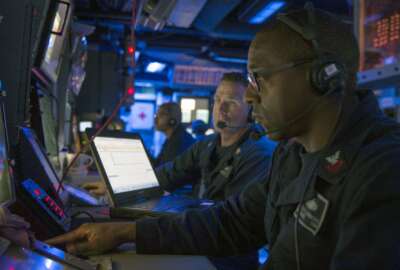
DISA’s first-ever production OTA eliminated $300M in future costs
DISA launched its cloud-based internet isolation program as a way to keep malware off of DoD networks, but it also reduced the need for expensive IT infrastruct...
The DoD Reporter’s Notebook is a weekly summary of personnel, acquisition, technology and management stories that may have fallen below your radar during the past week, but are nonetheless important. It’s compiled and published each Monday by Federal News Network DoD reporters Jared Serbu and Scott Maucione.
DISA OTA for cloud-based internet isolation a sign of more to come
The Defense Information Systems Agency’s first-ever use of an other transaction agreement (OTA) for production work came at an opportune time. Just as the pandemic was creating massive strains on DoD networks, the OTA gave DISA a brand new way to move huge amounts of traffic off of them.
In August, the agency awarded By Light Professional IT Services a nearly $200 million agreement to start deploying a technique called cloud-based internet isolation (CBII). As the name implies, the program moves Defense users’ web browsing off of their actual desktops and laptops; indeed, off of Defense networks entirely. The actual browsing activity happens in a commercial cloud environment.
The move was originally intended mainly as a security measure. After all, if the browser is in the cloud, any malware users happen to run across stays there too. But since the program keeps both good and bad traffic in the cloud, it also has the potential to dramatically reduce the amount of traffic that has to traverse through DoD internet access points.
Christopher Barnhurst, DISA’s executive deputy director, said CBII let DISA avoid an estimated $300 million in expenditures it would otherwise have had to make to expand the capacity of the interconnections between DoD’s own networks and the public internet.
“We have a constantly increasing demand for bandwidth capacity, and at the same time, we have sensor capacity for cyber defense, both of which can be restrictive. The department was on a path where those two things were increasing exponentially,” he said last week at an event hosted by AFCEA D.C. “CBII allowed us to think differently about how to solve that problem — not go down the linear path of just constantly upgrading capacity, but maybe figure out a way to offload some of that bandwidth and increase security at the same time. That’s the kind of mindset that I think will help us increase our speed and capability and break down barriers.”
DISA first began development work on CBII two years ago. By 2019, it had decided to use an other transaction agreement to prototype the concept, and two different firms had been piloting their technologies for about a year before the agency awarded By Light a follow-on agreement to deploy their approach at large-scale. It was DISA’s first use of a statutory authority that lets DoD move directly into production OTA contracts as long as the prototypes were awarded competitively.
But Steve Wallace, the systems innovation scientist for DISA’s emerging technologies directorate, said it’s unlikely to be the last.
“Where we started in our thinking with CBII is not actually where we ended up: Our thinking evolved over a year or two. And the OTA was key,” he said. “Without that, we would have written a set of requirements that likely, once it all played out, wouldn’t have been exactly what we want wanted. But it was a lot of work in partnership with industry that got us there, so we want to take that same philosophy and continually apply that and get faster about it.” —JS
Navy training sailors for future weapons systems
The military has put a lot of effort into trying to stay ahead of the curve when it comes to new technology. But, what about the people who will be using that technology?
The Navy is taking a hard look at itself to find out where it has “lethality training gaps,” areas where sailors may not be up to date on using the most state-of-the-art technology or may not be prepared for that technology when it comes out.
“This work will ensure that we are really ready to train for future capabilities like Constellation Class frigate plans, unmanned hypersonic, etc. before those platforms get here,” said Vice Adm. John Nowell, deputy chief of naval operations for personnel, training and education. “The team has done some ‘I worry’ work to align your internal structure to better focus on the warfighter in the future Navy.”
Nowell said the Navy is working to have a virtual training platform at every port, which can simulate new systems.
The Navy is also looking at its learning centers to see what gaps need to be fixed and what training systems they may need.
The Navy plans on closing its lethality gap by improving training systems, putting more curriculum online and putting an emphasis on high quality instructors.
“We need your passion, we need your expertise,” Nowell said. “Please know that we as a community we value this service, and we will reward it in training board and selection boards.”
The Navy is also focusing on improving training and education in other ways as well. The service just started its community college, which allows sailors, Marines and members of the Coast Guard to get college credit for some of their training.
“A key to building a mission-ready total workforce is investing in our people and their education,” said Gladys Brignoni, director of the Coast Guard’s Force Readiness Command. “The Naval Community College effort will help develop the skills of our workforce through formal education opportunities. This is an exciting opportunity for the Coast Guard and we look forward to all of the future possibilities this holds for our service and our workforce.” — SM
DoD still struggling to account for billions in intra-departmental transactions
If the Defense Department ever hopes to earn a clean opinion on its financial audits, one of the problems it will need to solve is the accounting discrepancies that happen when one part of DoD sells goods or services to another part. And it’s a big problem.
The Government Accountability Office’s latest review of DoD’s intra-departmental transactions – one of the many material weakness areas in the department’s financial statements – noted that DoD had to make corrections for $112 billion of those transactions as it closed out its 2019 books. Of those, $102 billion were deemed to be “unsupported.”
Those corrections, called “top-side adjustments,” come into play when, for example, the Air Force sells spare parts to the Navy, but their separate financial systems record different dollar amounts, or they’re not reported in the same quarter. If there’s no way to reconcile the differences with reliable data, the Defense Finance and Accounting Services simply changes one of the two amounts so that they match. And auditors tend to frown on that sort of thing.
DoD’s long-term plan to fix the problem is to have all the military services and Defense agencies adopt the Treasury Department’s G-Invoicing platform. The upside is that Defense components would all be using a single system with shared data about terms and conditions, orders, payments and delivery, pretty much eliminating the possibility that an Air Force system and a Navy system would disagree about what actually happened in a given transaction.
The downside is that DoD officials claim the Treasury system doesn’t actually meet their business needs in several key areas.
According to GAO, DoD wants G-Invoicing changed in several ways. For example, some of DoD’s transactions require sign-off by three or more senior officials; the Treasury system can only accommodate two. They’ve also complained the system can’t accommodate partial orders, and that some data elements in the system don’t match up with DoD’s needs to assign an accountable official for each transaction.
DoD has started developing workarounds in case Treasury doesn’t change its platform in the way the department wants, but there’s no telling how long either pathway will take. —JS
Army turning its soldiers into video game stars for recruitment
The Army is trying to mix virtual atmospheres with hands-on experiences to get Generation Z excited about joining the military.
The service is offering a deeper look into what it’s like to be a soldier by highlighting 12 career fields on social media platforms like Instagram, Twitter and YouTube between now and April 2.
The Army will follow 12 specific soldiers working in each of the fields by posting videos, interviews, account takeovers and other media.
“When we launched ‘What’s Your Warrior?,’ we established a new world for Gen Z to inhabit and explore its Army on their terms — and we know they liked what they saw thanks to a nearly 53% spike in online interest in the first year alone,” said Maj. Gen. Alex Fink, chief of Army Enterprise Marketing. “To continue the momentum, now we’re inviting youth deeper into this world through the eyes and experiences of real soldiers. Who better to introduce America’s youth to the wealth of opportunity in the U.S. Army than the soldiers who live and breathe it every day?”
The Army picked the 12 career fields out of a total of 200 possibilities. Each soldier is given a video game-type avatar. They include:
The Dragon Tamer (1st Lt. Phillip Fluke, Aviation Officer*): It takes a near-mythical level of skill to harness the power of an Army helicopter. Army pilots’ determination and specialized training allow them to do the seemingly impossible.
The Wavelength (Sgt. Jennifer Smith, Signal Support Systems Specialist): Signal warriors have the technical expertise to capture and send the critical communications we can’t see. This allows the seamless connection between units and the entire Army across the globe.
The Virus Hunter (Maj. Derese Getnet, Microbiologist): It takes a certain kind of power to confront and neutralize the not-so-little threats to human health. The microbiologists work to not only handle ongoing threats but ones that may occur in the future.
The Chameleon (Sgt. 1st Class Jean-Noel Howell, Infantryman*): A sniper gains a tactical advantage by disappearing into the landscape. Their mastery of stealth, reconnaissance, and weaponry makes them the deadliest unseen force on the battlefield.
The Thunder Maker (Staff Sgt. Jada Madson, Multiple Launch Rocket Systems Crewmember): Firing rockets and missiles from miles away, they provide tactical support and clear advantage on the battlefield with each resounding rocket impact and flash.
The Ground Breaker (Sgt. Frincee Prado, Technical Engineer): An expert in design and construction, the technical engineer imagines structures and works collaboratively with the engineering community to build them into existence.
The Code Fighter (Maj. Erika Alvarado, Cyber Operations Officer): The Army needs those with digital chops to hold the frontlines of the future. Here cyber warriors battle threats that attempt to come across the digital network day in and day out.
The Sharpened Steel (Col. Roy Danks, General Surgeon): As powerful as any weapon in battle, a surgeon’s expert skills can be the instrumental difference between life and death.
The Replenisher (Sgt. Josthin Josue Servellon Hernandez, Culinary Specialist): Army chefs fuel the force by providing the critical nutrition our Soldiers need to succeed in any mission.
The Force Multiplier (Sgt. Maj. Zachary Bowman, Special Forces Senior Sergeant): A “force multiplier” has the ability to scale their power. In this case, it’s the Special Forces Soldier’s training of indigenous forces to protect and defend themselves. Special Forces Soldiers have various roles they master, enabling them to be the solution in any climate and place.
The Nerve Center (Spc. Marian Jones, Intelligence Analyst): When the data pours in, it takes a corps of experts to analyze it and find the advantages, turning information into action.
The Upper Hand (Sgt. Javaughn Harrison, Unmanned Aircraft Systems Operator): With a mighty fleet at their fingertips, unmanned aircraft systems operators give their nation the ultimate aerial advantage.
The Army is changing to way it recruits in order to bring in more Gen Zers. The service is focusing more on urban areas than in the past and has created an esports team to engage with children. — SM
Caring for service members one text at a time
The Defense Health Agency is offering a limited-time program to keep service members and their families healthy during the coronavirus pandemic.
The My MilLife Guide is an eight-week “course” that sends text messages to the military community to boost overall wellness and navigate stress during COVID-19.
“Our service members and their families deserve the best possible care. I want to utilize all available tools to ensure their health, wellness, and readiness records are easily accessible,” said Army Col. Dr. Neil Page, deputy and military chief of the clinical support division for medical affairs at the Defense Health Agency. “The COVID-19 pandemic showed us that sometimes these tools are best provided through digital health services. We in the Military Health System are excited to partner with Military OneSource to provide a text-based wellness program that puts valuable resources at our beneficiaries’ fingertips, in a new and innovative way.”
The program will cover areas like stress relief, getting better sleep, self-care, strengthening relationships and managing finances.
The course prompts users to start each week with a goal and take small steps to accomplish that goal.
The program will end Feb. 12. Service members can sign up by testing “MilLife SM” to GOV311. Spouses can sign up by texting “MilLife Spouse” to the same number. Users can receive up to four text messages a week. — SM
Copyright © 2024 Federal News Network. All rights reserved. This website is not intended for users located within the European Economic Area.
Jared Serbu is deputy editor of Federal News Network and reports on the Defense Department’s contracting, legislative, workforce and IT issues.
Follow @jserbuWFED
Scott Maucione is a defense reporter for Federal News Network and reports on human capital, workforce and the Defense Department at-large.
Follow @smaucioneWFED
Related Stories






